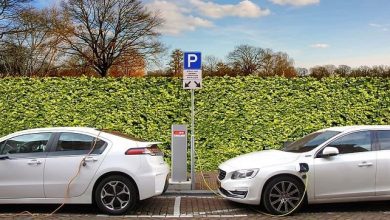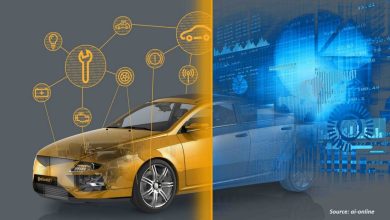ChatGPT for the Mobility Industry – Opportunities & Challenges

I. Introduction
Over the past couple of decades, the automotive industry has been undergoing tectonic shifts with advancements in technologies and introduction of alternate fuel and electric vehicles, advanced electronics, (semi) autonomous vehicles, connected vehicle features, and advanced safety systems. ChatGPT or Generative Pre-trained Transformer is one such technology that is increasingly disrupting multiple industries including automotive industry (Ref [1]-[3]). ChatGPT is a Large Language Model (LLM) developed by OpenAI that uses state-of-the-art natural language processing (NLP) and can generate human-like response in the form of text using supervised learning and Reinforcement Learning from Human Feedback (RLHF) based on large amounts of data containing 6 billion parameters (Ref [4], [5]). The breakthrough AI chatbot ChatGPT, a text-based, general-purpose productivity application developed using GPT-3.5, a LLM and conversational chatbot technology, has been welcomed by over a million users within a week of its debut in November 2022 and has already been tried across different industries such as education, travel and tourism, law, publishing, and marketing, to name a few (Ref [1], [6]). As increasing number of use cases are being envisioned for ChatGPT applications across different research and engineering domains, efforts are being made to evaluate how LLMs may disrupt the automotive industry to realize the Intelligent Transportation System (Ref [4]). Two schools of thought have already emerged with the proponents of ChatGPT
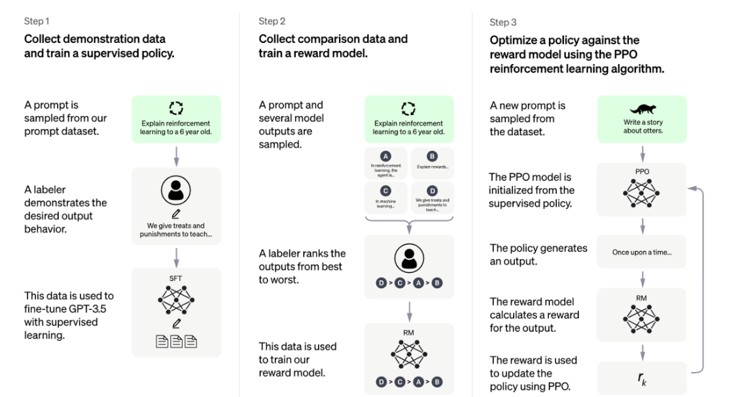
hailing it as a “powerful disruptor” that may require businesses to adapt (Ref [7]), may revolutionize and enhance the value addition in multiple sectors (Ref [8], [9]), and even enhance a brand sustainability strategy (Ref [10]) while its opponents caution against “blind belief”/hallucinations on the output generated by the tool (Ref [11]) with some critics warning about the impact on the labour market and elimination of millions of repetitive jobs that may get automated by the tool (Ref [12]).
As depicted in Figure 1 (Ref [5]), ChatGPT is being used to disrupt the automotive industry with improved customer engagement, intelligent voice assistance, upgraded manufacturing process, intelligent design of new vehicles, safer and secure vehicles, and improved overall driving experience. Like any disruptive technology, ChatGPT will also usher in greater technology-driven innovation and new business models in the automotive industry through multiple applications (Ref [13]). As reported in Ref ([14], [15]), General Motors (GM) is developing a virtual personal assistant based on the Artificial Intelligence (AI) models being used in the ChatGPT. GM plans to leverage their association with Microsoft on the autonomous vehicle capabilities in Cruise and add a software layer with more car-specific functions to enhance the ChatGPT and build an intelligent voice assistant.
Keywords: ChatGPT, AI/ML applications, Reinforcement Machine Learning, Human-Computer Interface (HCI), Reinforcement Learning from Human Feedback (RLHF), intelligent voice assistant
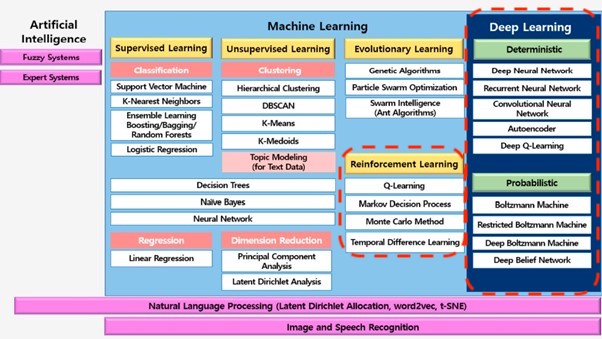
The classification of AI & ML applications is shown in Figure 2 (Ref [16]), with Reinforcement Learning and Deep Learning playing an important role in the development of ChatGPT.
II. Potential applications of ChatGPT in the Automotive Industry
Since its launch in November 2022, ChatGPT is being incorporated into multiple aspects of the automotive industry including design and engineering, customer service, manufacturing, supply chain, and quality control, to name a few (Ref [2], [3]).
In the area of Design and Engineering, ChatGPT may assist with streamlining and process efficiency improvement during the design and engineering phase in addition to automating the repetitive tasks such as development of technical documentation and 3D models. The in-built Artificial Intelligence (AI) feature of ChatGPT not only enhances automotive engineers’ ingenuity in design and conceptualization but also aids in suitable materials evaluation from performance, durability, and sustainability perspective.
ChatGPT can improve manufacturing processes through AI to a) optimize and streamline assembly lines from supply chain and ergonomics perspectives, b) identify and eliminate production bottlenecks, c) provide interactive chat-based instructions for assembly and sequencing of parts, d) give instant feedback to the workers on any issues and ensure they stay updated with latest information, and e) reduce errors and production downtime, improve efficiency, and overall productivity.
On enhanced customer service, AI-enabled chatbots and intelligent virtual assistants covering the gamut of ChatGPT provide real-time, faster, and effective feedback and support to the customers on vehicle features, optional fitments, financing deals, and leasing options, to name a few. Additionally, ChatGPT may also be used for special marketing initiatives to general and loyal customers on upcoming sales and deals.
As most of the modern vehicles are equipped with enhanced safety features and Advanced Driver Assistance Systems (ADAS), ChatGPT can not only improve on the driver distraction while driving but also in an improved Human-Computer Interface (HCI) and in the development of autonomous vehicles. With the advent of 5G networks and reduced latency, complex calculations and fast decisions can be made in split second by acquiring and processing massive amounts of real-time data collected from onboard cameras, radars, Lidars, GPS/GNSS sensors, ultrasound sensors, etc. In essence, ChatGPT can significantly contribute to improving the human interactions with vehicles, enhanced safety, and advanced autonomous driving features (Ref [17], [18]).
Owing to human-like interactions and quick and effective responses, ChatGPT can enhance a customer car-buying experience by providing multiple options on vehicle customization and by helping customers create individualized suggestions on vehicle features, standard and optional fitments and accessories, and exterior and interior colour combinations.
Another application of ChatGPT in the automotive industry would be in Quality Control during manufacturing and assembly which could be automated to analyse data from multiple cameras and sensors to identify dimensional tolerance issues and flaws during assembly, if any. AI and ChatGPT-enabled applications in quality control help towards reducing costly vehicle recalls and faster turnaround in identifying and fixing the manufacturing and assembly issues.
II A) Improved Human Computer Interface
Applications of ChatGPT in the automotive industry in improving Human Computer Interface (HCI) include a) enhanced voice assistance, b) improved interaction with the in-vehicle-infotainment (IVI) systems, c) strong correlation with ChatGPT, and d) reduced driver distraction (Ref [4]). Though the technology behind voice assistants has significantly improved over the past few years with accuracy of voice recognition currently well over 90%, the biggest pain point is understanding the voice commands and the context of the conversation. AI-enabled ChatGPT uses semantics besides continuous learning to constantly improve the understanding of voice. To enable effective execution of responses to the voice commands, ChatGPT works on large-scale data with human annotation and feedback to better understand the queries and give improved responses with appropriate actions.
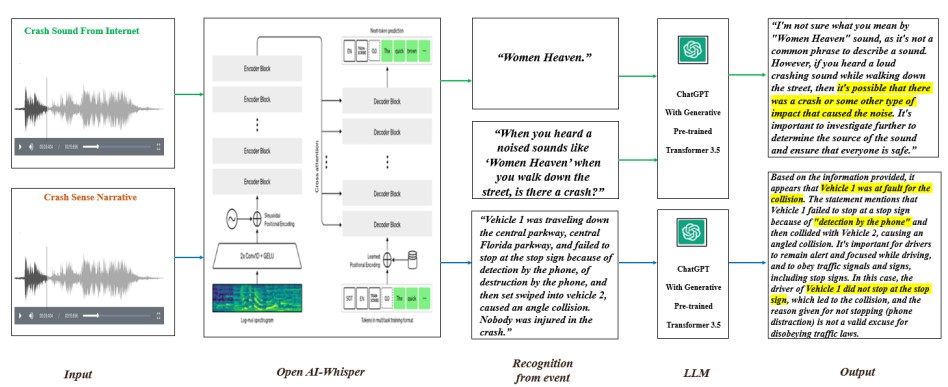
A schematic of a ChatGPT audio language model is shown in Figure 3 (Ref [4]) for a vehicle crash scenario. A variety of speech recognition models have been designed to recognize and transcribe spoken language from the audio inputs and are deployed in the mobility industry in multiple scenarios including crash and safety. In the case study shown in Figure 3, vehicle crash information is captured from both the crash sounds and the in-cockpit recording of the driver’s conversation before and during the crash. Then, keywords from both these inputs are extracted using the automatic speech recognition (ASR) application available with OpenAI’s Whisper tool, which are then input into the LLM of ChatGPT to generate an output containing detailed information on the crash including potential root cause analysis, sources of different noises during crash, and the driver who may be at fault.
II B) Enhanced Customer Engagement
Recent statistics indicate that a whopping 91% of car buyers do online research on the vehicles, features, local dealers, etc. before they physically visit a showroom. With the advent of AI chatbots such as ChatGPT, the online browsing/shopping experience of vehicle buyers could be further improved through interactive and conversational chats and outputs based on that customer browsing history and preferences instead of asking the customers to scroll through numerous buying options on models, features, colours, etc. (Ref [1]). ChatGPT could take the buying experience one step further with the customization of payment options, insurance policies, and leasing deals. As many of the vehicle dealers have started establishing their presence in Metaverse, customers can now have the luxury of immersive digital experience and 24/7 high-quality service support, ably assisted by ChatGPT in addressing the requests of a wide variety of customers and their vehicle-buying options. ChatGPT also improves operational efficiency by automating many of the routine tasks obviating the need for escalation or human intervention only on a need basis.
II C) Improved Safety
ChatGPT, with its inherent AI-enabled capabilities based on text or voice-to-text inputs, will help enhance the safety features in vehicles by enabling the drivers to focus on driving, preventing driver distraction, and providing appropriate responses to the inquiries (Ref [17], [18]). ChatGPT also has the inherent ability to seamlessly integrate with the In-Vehicle Infotainment (IVI) system, resulting in smoother and intuitive interactions and improving the overall driving experience besides enhancing safety. ChatGPT can interface with ADAS and semi-autonomous features such as Lane Departure Warning (LDW), Autonomous Emergency Braking (AEB), Frontal Collision Warning (FCW), etc. using onboard cameras and other sensors to carryout sensor data fusion and help take countermeasures to prevent collisions or crashes. ChatGPT, with its training model based on billions/trillions of parameters and ability to rapidly process and analyze data from disparate sources, cohesively processing them and coordinating with Reinforcement Learning from Human Feedback (RLHF), can do faster decision-making and take actions based on what a human being would likely to do in an impending crash/collision situation. The AI-enabled ChatGPT could synthesize multi-sensor data (Lidars, radars, cameras, etc.), interface with RLHF algorithms, get trained on multi-parameter big data, help develop autonomous driving decision-making model, and instantly provide drivers with actionable inputs or play a pivotal role in realizing the next generation of autonomous vehicles through anticipatory actions. ChatGPT can carry out voice interaction with the driver to ascertain his/her driving ability, detect drowsiness or inability to drive a vehicle in a safe manner and alert the driver and/or the authorities, as required.
Investigation into some of the recent accidents involving self-driving vehicles pointed to single-pixel errors and flaws in deep learning (DL) vision models while in other cases the root cause indicated that the entire autonomous driving system did not fully consider how to respond to the risky situation(s) as no hardware issues or software bugs could be identified, thus pointing towards a flawed vision and decision-making model in autonomous driving. It is generally observed that humans tend to drive around, avoid, or brake and stop when they are uncertain about unidentifiable objects in front of them. Researchers estimate that an AI-enabled GPT decision-making autonomous driving model with many parameters trained with RLHF algorithms may better mimic human-like behavior to handle accident-prone situations.
AI-enabled features in vehicles could also alert the local emergency rescue teams in case of accidents for faster response besides enabling the motor vehicle insurance companies to assess the damages and determining the liabilities and providing the repair/garage shops with accurate damage assessment.
Additional benefits of ChatGPT, besides safety, could be to provide predictive maintenance and enhanced navigation as the drivers could leverage the conversational capabilities and the improved HCI of the AI chatbot to seamlessly interact with the IVI instead of navigating through multiple menu options that may result in driver distraction and potential accidents. ChatGPT helps drivers not to take their eyes off the road to adjust HVAC controls, volume, or interact with an app while driving and thus prevents driver distraction. As many IVI systems do not have haptic feedback, ChatGPT, through voice controls, can understand and execute the driver commands/instructions.
II D) Improved Security
As cyberattacks on vehicles have more than doubled in the past few years, ChatGPT can act as a deterrent to detect and respond to potential security threats in real-time (Ref [19]-[21]). ChatGPT can be integrated into security systems to monitor suspicious activity 24/7, identify potential threats, and even alert authorities. As many vehicles offer connected and (semi) autonomous features and over-the-air (OTA) software updates through cloud-based subscriptions and services, ChatGPT can play a vital role in the IT infrastructure in the mobility industry and significantly improve cloud security by analyzing log data, identifying potential threats, and even suggesting remedial steps. ChatGPT, integrated with AI, can quickly respond to security incidents, reduce, or prevent the risk of data breaches, and protect sensitive data.
II E) Risks associated with ChatGPT in Autonomous Vehicles
As shown in Figure 2 (Ref [16]), Deep Learning (DL) models are used extensively in LLMs such as ChatGPT, which when used in the context of autonomous vehicles can still pose a danger with potential accidents being caused by single-pixel errors (Ref [20]). Researchers noted that during the implementation of Vehicle-to-Infrastructure (V2I) protocol in autonomous driving, deliberately introducing errors in the computer vision model such as changing a pixel in the original image might be interpreted by the LLM as traffic light colour changing from red to green, leading to potential accidents even from an error caused by a single pixel change. Even such a seemingly trivial error could be caused by hardware failure such as a bit error in RAM or a problem with the logic of a certain adder or multiplier (Ref [20]) and need not arise from a deliberate cyberattack. ChatGPT is also likely to be targeted by prompt injection cyberattacks that may adversely impact the computer vision models in autonomous vehicles.
III ChatGPT – A word of caution on usage
ChatGPT, like any tool that utilizes big data, is susceptible to data privacy and security concerns. The industry and the community will continue to deliberate on the trade-offs between enhanced personal digital experiences and protection of sensitive personal data. ChatGPT is susceptible to hallucinations (Ref [11]) and sometimes provides incorrect answers to prompts. It also reflects the deficiencies of its training corpus, which can lead to biased or inappropriate responses as well as algorithmic bias. Use of ChatGPT presents risks when personally identifiable or sensitive information is entered in a prompt, which raises the question of “accountability” – who will be held responsible and accountable if AI chatbots such as ChatGPT provide incorrect or inaccurate responses? Despite these shortcomings, ChatGPT has awoken the late majority interest in AI due to its unprecedented capabilities and applications. However, the risk of inaccuracy means that humans must still monitor input/output to ChatGPT, as it produces inaccurate answers in 20% to 30% of cases.
Conclusions
Artificial Intelligence (AI) and Machine Learning (ML) applications are found in multiple industries and sectors. AI chatbots such as ChatGPT can be successfully deployed in the mobility industry in multiple applications including customer care, human-computer interface, intelligent voice assistance, predictive maintenance, enhanced safety, improved security, vehicle customization, and autonomous driving, to name a few. ChatGPT will also improve operational efficiency through automation of repeated tasks so the engineers, technicians, salespeople, etc. could focus on more innovative activities. AI/ML-based algorithms play a critical role in fuel efficiency enhancement in conventional vehicles or driving range improvement in electric vehicles. A word of caution is advised while using ChatGPT in autonomous vehicles due to potential failures from single-pixel errors or prompt injection cyberattacks (though less likely). The ChatGPT community continues to debate on responsibility and accountability due to the known hallucinations of ChatGPT, data privacy and security concerns, and incorrect or misleading outputs generated by it.
Future Work
AI/ML applications in the automotive industry and in autonomous vehicles have been around for many years now. Though the introduction of ChatGPT has created a massive buzz in different sectors including mobility industry, it is premature to predict how it may evolve and impact the industry. OpenAI released GPT-4 version on 14th March 2023, with early results confirming that it outperforms GPT-3.5 (the LLM on which ChatGPT was based) and improves the accuracy of output though there is only a marginal improvement in the levels of hallucination (factual error rate still around 20% to 30%). GPT-4 includes plug-ins that expand ChatGPT use cases and enable ChatGPT to access more timely information, run computations, and use third-party services. Experts opine that highly complex use cases and associated data need to be tried on GPT-4 to make it more reliable, accurate, and responsive to human-like conversations and discern the improvements over GPT-3.5.
ChatGPT has been evolving into multiple applications including Multi-Modal Large Learning Model (MM-LLM), a reference architecture for which is shown in Figure 4 (Ref [4]). The unique aspect of this MM-LLM is the smartphone-based crash report auto-generation framework. As smartphones have become ubiquitous and can inherently carry multiple features such as camera (photos, videos), audio recording, and sensors such as GPS, gyro, etc. they can be easily interfaced with MM-LLM that contains four major functions that are needed for complete crash report generation, namely, Visual Question-Answering (VQA), Natural Language Understanding (NLU), Natural Language Generation (NLG), and speech recognition. In the event of a vehicle crash or accident, photos of the crash scene can be taken by a smartphone with MM-LLM and transferred to the linguistic representation spaces through a vision encoder to execute VQA. Additional inputs such as Driver Narrative, Crash GPS location etc. are also input into LLM. With all the crash-related inputs, the LLM encodes it into a high-dimension matrix and generates a complete crash report. This could be used for accident investigation, liability assessment, loss estimation, insurance payment amount, potential repair or garages where the vehicle could be fixed, etc.
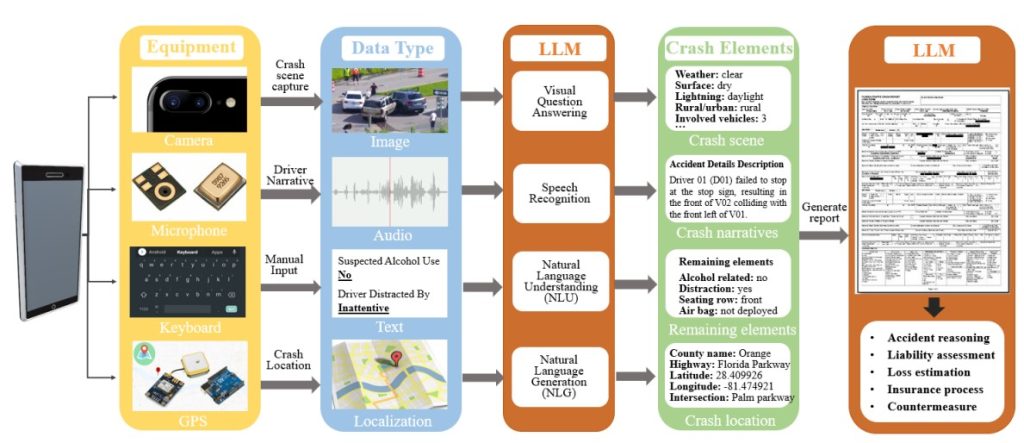
While this continues to excite the researchers and industry practitioners, users must be cautioned to temper down their expectations on the future of AI with the continued challenges of data security and privacy concerns still plaguing the mobility industry that is also evolving to counter the alarming rise of cyberattacks.
References
1. Vijayakumar, J.P and Shetty, A., “Automotive industry and ChatGPT: Striking a balance between human ingenuity and Artificial Intelligence,” March 1, 2023, https://www.frost.com/frost-perspectives/automotive-industry-and-chatgpt-striking-a-balance-between-human-ingenuity-and-artificial-intelligence/
2. Zaveria, “Potential applications of ChatGPT in the automotive industry,” April 3, 2023, https://www.analyticsinsight.net/potential-applications-of-chatgpt-in-the-automotive-industry/
3. Schultz, J. “ChatGPT for the automotive industry,” April 6, 2023, https://www.drivecentric.com/resources/chatgptfortheautomotiveindustry
4. Zheng, O., et. al, “ChatGPT is on the horizon: Could a Large Language Model be all we need for intelligent transportation?” https://arxiv.org/ftp/arxiv/papers/2303/2303.05382.pdf doi:10.48550/arXiv.2303.05382
5. Wu, Z. and Li, M. “ChatGPT’s impact on the automotive industry,” https://equalocean.com/analysis/2023021719474
6. Baker V. and Mullen, A. “ChatGPT Research Highlights,” published April 5, 2023, ID G00790353, Gartner, Inc. https://www.gartner.com/en/articles/chatgpt-research-highlights
7. Edelman, D.C. and Abraham, M. “Generative AI will change your business: Here’s how to adapt,” Harvard Business Review, April 12, 2023, https://hbr.org/2023/04/generative-ai-will-change-your-business-heres-how-to-adapt
8. Briggs, J. and Kodnani, D., “The potentially large effects of Artificial Intelligence on economic growth,” Goldman Sachs Economics Research, 26 March 2023, https://www.ansa.it/documents/1680080409454_ert.pdf
9. Deng, J. and Lin, Y., “The benefits and challenges of ChatGPT: An overview,” Frontiers in Computing and Intelligent Systems, ISSN: 2832-6024, Vol 2, No. 2, 2022, https://doi.org/10.54097/fcis.v2i2.4465
10. Farook, R., “How ChatGPT can help propel brand sustainability strategies,” https://sustainablebrands.com/read/product-service-design-innovation/chatgpt-propel-brand-sustainability-strategies
11. Smith, C.G., “Hallucinations could blunt ChatGPT’s success,” March 13, 2023, https://spectrum.ieee.org/ai-hallucination
12. Eloundou, T. et. al, “GPTs are GPTs: An early look at the labor market impact potential of Large Language Models,” https://arxiv.org/pdf/2303.10130.pdf
13. “Mercedes Benz is experimenting with chatGPT AI chatbot in cars – is it any good?,”
https://www.motortrend.com/news/mercedes-benz-chatgpt-ai-artificial-intelligence-interior-review/
15. Jones, J., “The tech behind chatGPT could power your next car’s AI driving assistant,”
https://www.thankful.ai/chatgpt-for-customer-service
16. Lee, M. “An analysis of the effects of artificial intelligence on electric vehicle technology innovation using patent data,” World Patent Information 63 (2020), 102002, https://doi.org/10.1016/j.wpi.2020.102002
17. “ChatGPT says Connected Cars: The future of automotive technology,”
18. Hope, G., “VW Group and Microsoft join forces to build autonomous cars,” February 15, 2021,
https://aibusiness.com/companies/vw-group-and-microsoft-join-forc -to-build-autonomous-cars
19. Nandi, A. “ChatGPT: Revolutionizing information security and cloud security,” February 24, 2023, https://www.haptik.ai/tech/chatgpt-revolutionizing-security#
20. Yu, Y-C, “ChatGPT’s impact on automotive security and safety,”
https://vicone.com/blog/chatgpts-impact-on-automotive-security-and-safety
21. Chilton, J. “The new risks ChatGPT poses to Cybersecurity,” Harvard Business Review, April 21, 2023, https://hbr.org/2023/04/the-new-risks-chatgpt-poses-to-cybersecurity
Dr. Arunkumar M. Sampath works as a Principal Consultant in Tata Consultancy Services (TCS) in Chennai. His interests include Hybrid and Electric Vehicles, Connected and Autonomous Vehicles, 5G/6G, Cybersecurity, Functional Safety, Advanced Air Mobility (AAM), AI, ML, Data Analytics, and Data Monetization Strategies

